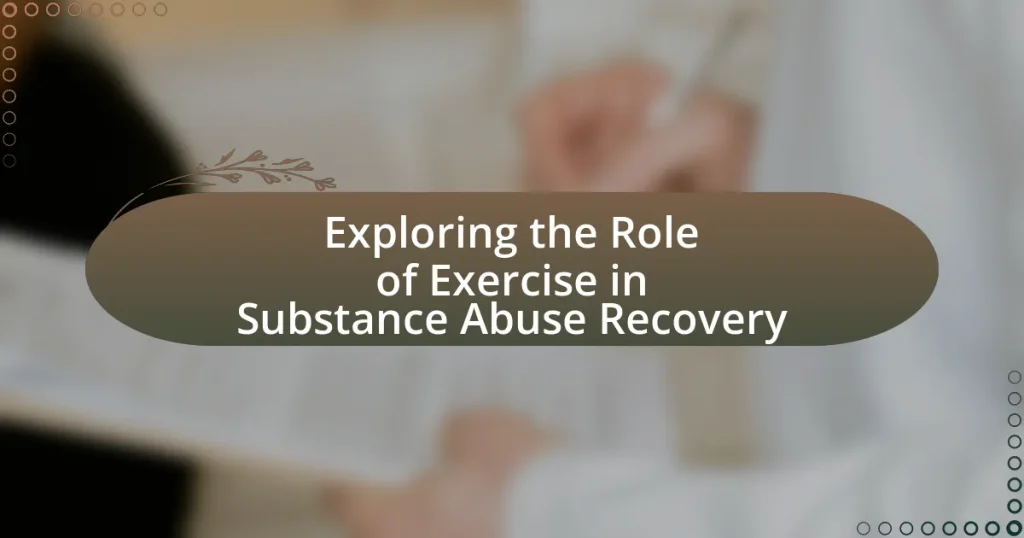The article explores the critical role of exercise in substance abuse recovery, highlighting its benefits for physical health, mental well-being, and relapse prevention. It discusses how regular physical activity alleviates symptoms of anxiety and depression, enhances mood through endorphin release, and fosters social connections among individuals in recovery. The article also examines the physiological changes that occur during exercise, the psychological benefits it provides, and the effectiveness of various types of exercise in improving recovery outcomes. Additionally, it offers practical strategies for incorporating exercise into recovery plans, emphasizing the importance of professional guidance and goal-setting to enhance adherence and motivation.

What is the role of exercise in substance abuse recovery?
Exercise plays a crucial role in substance abuse recovery by promoting physical health, enhancing mental well-being, and reducing the likelihood of relapse. Engaging in regular physical activity helps to alleviate symptoms of anxiety and depression, which are common among individuals in recovery. Research indicates that exercise increases the production of endorphins, neurotransmitters that improve mood and reduce stress, thereby supporting emotional stability during the recovery process. Additionally, a study published in the Journal of Substance Abuse Treatment found that individuals who participated in exercise programs reported lower levels of cravings and improved coping skills, further validating the positive impact of exercise on recovery outcomes.
How does exercise contribute to the recovery process?
Exercise significantly contributes to the recovery process by enhancing physical health, improving mental well-being, and fostering social connections. Engaging in regular physical activity can lead to the release of endorphins, which are natural mood lifters, thereby reducing symptoms of anxiety and depression commonly associated with substance abuse recovery. Research published in the Journal of Substance Abuse Treatment indicates that individuals who incorporate exercise into their recovery plan experience lower relapse rates and improved overall mental health. Additionally, exercise can help rebuild physical strength and stamina, which may have been compromised during substance use, further supporting the recovery journey.
What physiological changes occur in the body during exercise that aid recovery?
During exercise, the body undergoes several physiological changes that aid recovery, including increased blood circulation, enhanced oxygen delivery, and the release of endorphins. Increased blood circulation helps to deliver nutrients and oxygen to muscles, facilitating repair and reducing soreness. Enhanced oxygen delivery improves aerobic capacity and energy production, which are crucial for recovery. The release of endorphins during exercise contributes to pain relief and improved mood, which can be particularly beneficial in the context of substance abuse recovery by reducing stress and anxiety. These physiological changes collectively support the body’s healing processes and promote overall well-being.
How does exercise impact mental health during recovery?
Exercise significantly improves mental health during recovery by reducing symptoms of anxiety and depression. Engaging in physical activity releases endorphins, which are natural mood lifters, and can lead to increased feelings of well-being. Research indicates that individuals who incorporate regular exercise into their recovery process experience lower levels of stress and improved self-esteem. A study published in the Journal of Substance Abuse Treatment found that participants who exercised regularly reported a 30% reduction in depressive symptoms compared to those who did not engage in physical activity. This evidence supports the conclusion that exercise plays a crucial role in enhancing mental health outcomes for individuals in recovery from substance abuse.
Why is exercise considered a complementary treatment for substance abuse?
Exercise is considered a complementary treatment for substance abuse because it promotes physical and mental well-being, which can aid in recovery. Engaging in regular physical activity has been shown to reduce cravings, alleviate withdrawal symptoms, and improve mood by increasing the production of endorphins and other neurotransmitters. Research indicates that exercise can enhance the effectiveness of traditional therapies; for instance, a study published in the Journal of Substance Abuse Treatment found that individuals who participated in exercise programs alongside standard treatment reported lower relapse rates and improved psychological health. This evidence supports the integration of exercise into comprehensive substance abuse recovery plans.
What evidence supports the effectiveness of exercise in recovery programs?
Exercise significantly enhances recovery outcomes in substance abuse programs. Research indicates that physical activity can reduce cravings, improve mood, and increase overall well-being. A study published in the Journal of Substance Abuse Treatment found that participants who engaged in regular exercise reported lower levels of substance use and higher levels of motivation to remain sober. Additionally, a meta-analysis in the journal Health Psychology Review demonstrated that exercise interventions lead to significant reductions in anxiety and depression, which are common co-occurring issues in individuals recovering from substance abuse. These findings collectively support the effectiveness of exercise as a critical component in recovery programs.
How do different types of exercise affect recovery outcomes?
Different types of exercise significantly influence recovery outcomes in individuals overcoming substance abuse. Aerobic exercises, such as running or cycling, enhance cardiovascular health and release endorphins, which can improve mood and reduce cravings. Resistance training, on the other hand, builds muscle strength and can boost self-esteem, contributing positively to mental health during recovery. Research indicates that a combination of both aerobic and resistance training leads to better overall recovery outcomes, as it addresses both physical and psychological aspects of addiction recovery. A study published in the Journal of Substance Abuse Treatment found that participants engaging in regular physical activity reported lower levels of substance use and improved emotional well-being, highlighting the effectiveness of exercise in supporting recovery.

What are the psychological benefits of exercise in recovery?
Exercise significantly enhances psychological well-being during recovery from substance abuse. Engaging in physical activity can reduce symptoms of anxiety and depression, which are common in individuals recovering from addiction. Research indicates that exercise promotes the release of endorphins, neurotransmitters that improve mood and create feelings of euphoria. A study published in the Journal of Substance Abuse Treatment found that individuals who participated in regular exercise reported lower levels of stress and improved self-esteem. Additionally, exercise fosters social interaction and support, which are crucial for emotional resilience during recovery. These psychological benefits collectively contribute to a more effective recovery process, helping individuals maintain sobriety and improve their overall mental health.
How does exercise influence mood and emotional well-being?
Exercise significantly enhances mood and emotional well-being by promoting the release of endorphins, which are chemicals in the brain that act as natural painkillers and mood elevators. Engaging in physical activity has been shown to reduce symptoms of anxiety and depression, as evidenced by a study published in the Journal of Clinical Psychiatry, which found that regular exercise can lead to a 20-30% reduction in depressive symptoms. Additionally, exercise improves self-esteem and cognitive function, contributing to overall emotional resilience. The physiological effects of exercise, such as increased blood flow and oxygenation to the brain, further support mental health by fostering a sense of accomplishment and reducing stress levels.
What role does exercise play in reducing anxiety and depression?
Exercise plays a significant role in reducing anxiety and depression by promoting the release of endorphins and improving overall mood. Engaging in physical activity has been shown to decrease levels of stress hormones, such as cortisol, while simultaneously increasing neurotransmitters like serotonin and dopamine, which are crucial for mood regulation. Research published in the journal “JAMA Psychiatry” indicates that regular exercise can lead to a 20-30% reduction in symptoms of anxiety and depression. Additionally, a meta-analysis in “Psychological Bulletin” found that exercise is as effective as medication for some individuals in alleviating depressive symptoms. These findings underscore the importance of incorporating exercise into treatment plans for anxiety and depression.
How can exercise improve self-esteem and confidence in recovering individuals?
Exercise can significantly improve self-esteem and confidence in recovering individuals by promoting physical health, enhancing mood, and fostering a sense of achievement. Engaging in regular physical activity releases endorphins, which are chemicals in the brain that act as natural mood lifters, thereby reducing feelings of anxiety and depression commonly experienced during recovery. A study published in the Journal of Substance Abuse Treatment found that individuals who participated in exercise programs reported higher self-esteem and improved body image compared to those who did not engage in physical activity. Additionally, setting and achieving fitness goals can provide a sense of accomplishment, reinforcing self-worth and confidence in one’s abilities.
What social benefits can exercise provide during recovery?
Exercise provides significant social benefits during recovery from substance abuse by fostering community connections and enhancing social support networks. Engaging in group exercise activities, such as fitness classes or team sports, allows individuals in recovery to build relationships with others who share similar goals, thereby reducing feelings of isolation. Research indicates that social support is crucial for maintaining sobriety, as individuals with strong social ties are more likely to adhere to recovery programs and experience lower relapse rates. A study published in the Journal of Substance Abuse Treatment found that participants who engaged in physical activities reported improved social interactions and a greater sense of belonging, which are vital for long-term recovery success.
How does group exercise foster community and support among individuals in recovery?
Group exercise fosters community and support among individuals in recovery by creating a shared environment that encourages connection and accountability. Engaging in physical activity together allows participants to bond over common goals, reducing feelings of isolation often experienced during recovery. Research indicates that social support is crucial for successful recovery outcomes; a study published in the Journal of Substance Abuse Treatment found that individuals who participated in group activities reported higher levels of social support and lower relapse rates. Additionally, group exercise promotes a sense of belonging, as members motivate each other, share experiences, and celebrate progress, reinforcing positive behaviors and emotional resilience.
What types of social interactions are encouraged through exercise programs?
Exercise programs encourage various types of social interactions, including teamwork, peer support, and community engagement. Teamwork is fostered through group activities such as team sports or fitness classes, where participants collaborate towards common fitness goals. Peer support is cultivated in environments where individuals share experiences and motivate each other, which is particularly beneficial in recovery settings. Community engagement occurs through organized events, such as charity runs or group challenges, that bring individuals together for a shared purpose, enhancing social bonds and reducing feelings of isolation. These interactions are vital in substance abuse recovery, as they promote accountability and a sense of belonging, which are essential for long-term recovery success.

How can individuals incorporate exercise into their recovery plans?
Individuals can incorporate exercise into their recovery plans by establishing a consistent routine that includes physical activity tailored to their abilities and preferences. Engaging in regular exercise, such as aerobic activities, strength training, or yoga, has been shown to reduce cravings, improve mood, and enhance overall well-being, which are crucial for individuals recovering from substance abuse. Research published in the Journal of Substance Abuse Treatment indicates that exercise can significantly decrease relapse rates and improve psychological resilience among recovering individuals. By integrating exercise into daily life, individuals can foster a healthier lifestyle that supports their recovery journey.
What types of exercise are most beneficial for those in recovery?
Aerobic exercises, strength training, and yoga are the most beneficial types of exercise for individuals in recovery from substance abuse. Aerobic exercises, such as running, swimming, or cycling, enhance cardiovascular health and release endorphins, which can improve mood and reduce cravings. Strength training helps build muscle and improve self-esteem, while yoga promotes mindfulness and stress reduction, which are crucial for maintaining sobriety. Research published in the Journal of Substance Abuse Treatment indicates that regular physical activity can significantly reduce relapse rates and improve overall mental health in recovering individuals.
How can individuals choose the right exercise regimen for their needs?
Individuals can choose the right exercise regimen for their needs by assessing their personal fitness goals, current physical condition, and preferences. This tailored approach ensures that the selected activities align with individual capabilities and desired outcomes, such as improving strength, endurance, or mental well-being. Research indicates that exercise can significantly aid in substance abuse recovery by enhancing mood and reducing cravings, making it crucial for individuals to engage in activities they enjoy and can sustain over time. For instance, a study published in the Journal of Substance Abuse Treatment found that participants who incorporated regular physical activity into their recovery process reported lower relapse rates and improved psychological health. Therefore, individuals should consider these factors and seek professional guidance if necessary to create an effective and enjoyable exercise regimen.
What are some recommended activities for beginners in recovery?
Recommended activities for beginners in recovery include walking, yoga, and group sports. Walking provides a low-impact way to improve physical health and mental well-being, making it accessible for most individuals. Yoga promotes mindfulness and stress reduction, which are crucial for those in recovery. Group sports foster social connections and teamwork, helping to build a support network. Engaging in these activities can enhance physical fitness, reduce cravings, and improve overall mood, supporting the recovery process effectively.
What strategies can enhance the effectiveness of exercise in recovery?
Incorporating structured exercise routines, mindfulness practices, and social support can significantly enhance the effectiveness of exercise in recovery from substance abuse. Structured exercise routines, such as aerobic activities and strength training, have been shown to improve mood and reduce cravings, as evidenced by a study published in the Journal of Substance Abuse Treatment, which found that participants engaging in regular physical activity reported lower levels of substance use and improved psychological well-being. Mindfulness practices, including yoga and meditation, complement physical exercise by promoting mental clarity and emotional regulation, further aiding recovery. Additionally, social support from group exercise programs fosters a sense of community and accountability, which is crucial for maintaining motivation and commitment to recovery. Research indicates that individuals who participate in group-based exercise programs experience higher retention rates and better recovery outcomes, highlighting the importance of social interaction in the recovery process.
How can setting goals improve exercise adherence during recovery?
Setting goals can significantly improve exercise adherence during recovery by providing clear direction and motivation. Specific, measurable, achievable, relevant, and time-bound (SMART) goals help individuals focus on their progress and maintain commitment to their exercise routines. Research indicates that goal-setting enhances self-efficacy, which is crucial for sustaining behavior change. For instance, a study published in the Journal of Substance Abuse Treatment found that participants who set specific fitness goals were more likely to engage in regular exercise compared to those without defined objectives. This structured approach not only fosters accountability but also allows individuals to celebrate small victories, reinforcing their commitment to recovery through consistent exercise.
What role does professional guidance play in creating an exercise plan?
Professional guidance is essential in creating an exercise plan as it ensures the plan is tailored to individual needs, abilities, and recovery goals. Trained professionals, such as certified personal trainers or exercise physiologists, assess a person’s physical condition and provide expertise in designing safe and effective workouts. Research indicates that personalized exercise regimens can enhance motivation and adherence, which are critical for individuals in substance abuse recovery. For instance, a study published in the Journal of Substance Abuse Treatment found that structured exercise programs led to improved outcomes in recovery, highlighting the importance of professional oversight in optimizing exercise benefits.
What are some practical tips for maintaining an exercise routine in recovery?
To maintain an exercise routine in recovery, individuals should establish a consistent schedule, set realistic goals, and choose enjoyable activities. A consistent schedule helps create a habit, making it easier to integrate exercise into daily life. Setting realistic goals, such as starting with short sessions and gradually increasing duration, prevents feelings of overwhelm and promotes a sense of achievement. Engaging in enjoyable activities, like group classes or outdoor sports, enhances motivation and adherence to the routine. Research indicates that regular physical activity can significantly improve mood and reduce cravings, supporting long-term recovery efforts.
